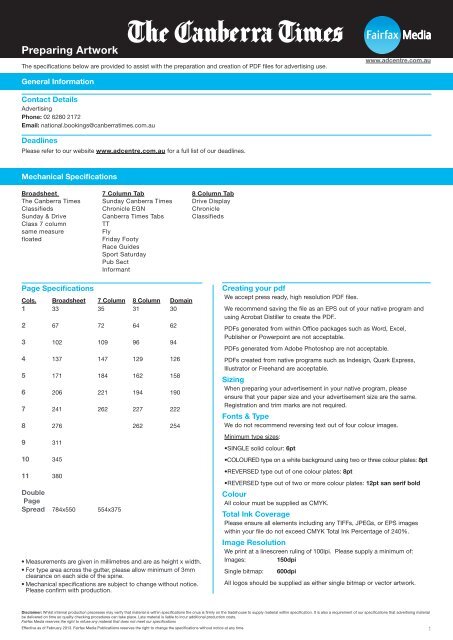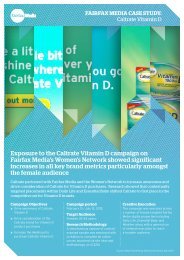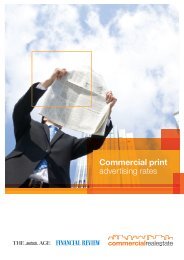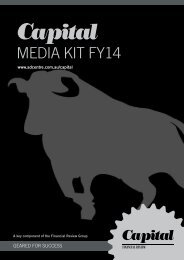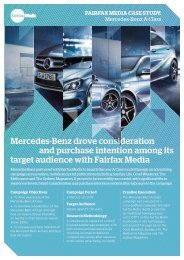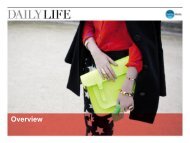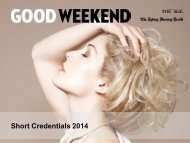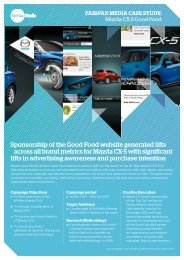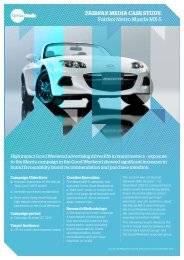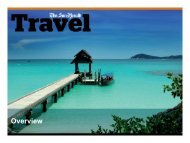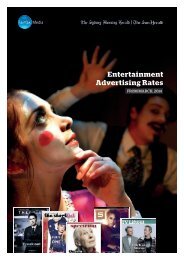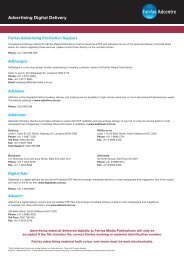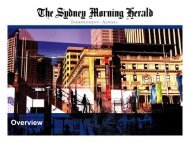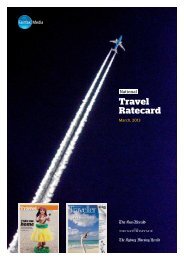Canberra Times Newspaper Specifications - Fairfax Media Adcentre
Canberra Times Newspaper Specifications - Fairfax Media Adcentre
Canberra Times Newspaper Specifications - Fairfax Media Adcentre
You also want an ePaper? Increase the reach of your titles
YUMPU automatically turns print PDFs into web optimized ePapers that Google loves.
Preparing Artworkwww.adcentre.com.auDelivery Channels<strong>Fairfax</strong> Advertising Production SupportComplete advertising material for <strong>Fairfax</strong> <strong>Media</strong> Publications must be saved as a PDF and delivered via one of the approved delivery channels listedbelow. For advice regarding these services, please contact them directly on the numbers shown.Phone: +61 1300 666 326Adstream* +Adstream (formerly Quickcut) provides software to assist with PDF validation and can arrange delivery of your ad on a fee-for-service basis to mostnewspapers and magazines in Australia. More information is available at www.adstream.com.auSydneyMelbourneLevel 5, Tower B, 207 Pacific Highway, St. Leonards NSW 2065 Level 1,15-29 Bank Street, South Melbourne VIC 3205Phone: +61 2 9467 7500 Phone: +61 3 8696 5701Toll Free: 1800 230 302 Fax: +61 3 9696 4556Fax: +61 2 9467 7602Tech Support: 1300 768 988BrisbaneAdelaideCnr Riverside Drive and Jane Street, West End QLD 4101 64 North Terrace, Kent Town SA 5067Phone: +61 7 3013 6279 Phone: +61 8 8366 0914Fax: +61 7 3013 6298 Fax: +61 8 8366 0909Digital Ads International SENDlite * +SENDlite is a collaboration between <strong>Fairfax</strong> and Digital Ads International to enable fast, easy and hassle-free delivery of advertising material direct to<strong>Fairfax</strong> newspapers by entering your booking number. Any minor issues are fixed on the fly for FREE. The website address is: www.sendlite.com.auLevel 2, 661 Darling Street, Rozelle NSW 2039Phone: +61 2 9818 1965Fax: +61 2 9818 5754Adsend* +Adsend (formerly Websend) is a digital delivery service that will validate PDF files and arrange immediate delivery of ads to most newspapers andmagazines in Australia. For more information visit www.adsend.com.au180 Bank Street, South Melbourne VIC 3205Phone: +61 3 8689 9000Toll Free: 1300 798 949Fax: +61 3 9614 5344AdDesigns +AdDesigns is a one stop design solution specialising in meeting customer needs in all <strong>Fairfax</strong> <strong>Media</strong> Publications.Suite 7 Level 3, 26 Castlereagh St, Liverpool NSW 2170Phone: +61 2 8777 6956Fax: +61 2 8777 6693Email: addesigns@fairfaxmedia.com.auAdvertising material delivered digitally to <strong>Fairfax</strong> <strong>Media</strong> Publications will only beaccepted if the file includes the correct <strong>Fairfax</strong> booking or material identification number.Disclaimer: Whilst internal production processes may verify that material is within specifications the onus is firmly on the tradehouse to supply material within specification. It is also a requirement of our specifications that advertising materialbe delivered on time so quality checking procedures can take place. Late material is liable to incur additional production costs.<strong>Fairfax</strong> <strong>Media</strong> reserves the right to refuse any material that does not meet our specificationsEffective as of February 2013. <strong>Fairfax</strong> <strong>Media</strong> Publicatiions reserves the right to change the specifications without notice at any time.2
Preparing ArtworkThe specification below is provided to assist with the preparation and creation of PDF files for advertising use.www.adcentre.com.auPDF CreationDigital advertisementsSubmitted to <strong>Fairfax</strong> must be saved as Portable Document Format (PDF).Please note that PDF files must be created with a PostScript application.PDF versions higher than V1.3 are not supported.Fully rasterised PDF’s from, or placed in any application are not accepted, due to extremely poorreproduction of fonts.The following applications are not PostScript compatible and are not suitable for creating PDF’sfor <strong>Fairfax</strong>:Microsoft WordMicrosoft PowerPointMicrosoft PublisherAdobe PhotoShopInstructions for creating PDF filesThe preferred method for creating a PDF file is shown below.Step 1Create an EPS file using a PostScript software application. Instructions for popular PostScript applications can be found here:InDesign CSllustrator CSStep 2Convert the EPS to PDF using Adobe Acrobat Distiller. Job Options for Distiller can be accessed via the Attachments Pane in this PDF.Distiller JoboptionsPhotoshop Colour Settings FileA Colour Settings File (CSF) has been developed to use Photoshop to enable effective image conversion from RGB to CMYK or RGB to Greyscale.In converting the image this file will also adjust maximum ink weight and incorporate Grey Component Replacement (GCR) settings for newsprint.The Photoshop CSF file with magazine settings can be downloaded via the link below:Click Here for CSF FileClick Here for ICC ProfileDisclaimer: Whilst internal production processes may verify that material is within specifications the onus is firmly on the tradehouse to supply material within specification. It is also a requirement of our specifications that advertising materialbe delivered on time so quality checking procedures can take place. Late material is liable to incur additional production costs.<strong>Fairfax</strong> <strong>Media</strong> reserves the right to refuse any material that does not meet our specificationsEffective as of February 2013. <strong>Fairfax</strong> <strong>Media</strong> Publicatiions reserves the right to change the specifications without notice at any time.3
Technical Reproduction GuidelinesDelivery Requirementswww.adcentre.com.auThe delivery and receipt of advertising material via Quickcut and Adsend is an automated workflow. As a result material instructions are not able to beviewed and should be communicated to your <strong>Fairfax</strong> <strong>Media</strong> sales contact.Booking NumberThere are a number of mandatory fields that must be completed priorto your ad being transmitted via one of our approved delivery channels.One of these fields is the booking number/material id number. Pleasecontact your <strong>Fairfax</strong> <strong>Media</strong> sales representative to obtain this number.Alternatively you can contact the Advertising Production team on(02) 9282 3322.Storage & Repeats<strong>Fairfax</strong> will store digitally supplied material for a period of three months.Repeat material instructions are to be supplied to your <strong>Fairfax</strong> salesrepresentative (not Quickcut or Adsend). <strong>Fairfax</strong> <strong>Media</strong> requires thebooking number and publishing date of the material to be repeated.It is, however, advisable to re-send the ad material for each insertion,to ensure that you run the material you require.Material Requirements / Production GuidelinesGeneralPDF version 1.3PostScript level 3ICC compliantColour modelNoCMYK onlyFonts & TypeType that has been set outside the recommendations shownis likely to reproduce poorly. <strong>Fairfax</strong> will not accept anyclaim for compensation for poor type reproduction wherethese recommendations have not been met. Ads with typeset outside <strong>Fairfax</strong> recommendations are accepted and runentirely at the advertisers risk.ImagesFormatEPS, TIFFMinimum resolution for colour images150dpiMinimum resolution for greyscale images150dpiMinimum resolution for black & white (single bit) images 600dpiTotal ink weight 240%Dot aim point (C,M,Y,K) for Catchlights 0%,0%,0%,0%Dot aim point (C,M,Y,K) for Highlights 0%,0%,0%,0%Dot aim point (C,M,Y,K) for non essential whites 0%,0%,0%,0%Auto Ink Weight Management<strong>Fairfax</strong> <strong>Media</strong> has state of the art ink weight adjustment software inplace, any material supplied with ink weight exceeding the specified240% limit will be automatically adjusted.Please consult Technical Reproduction Guidelines for eachnewspaper before submitting any artwork.Font embedding requiredYesFont subsetting allowedYesRecommended point size for coloured type8ptRecommended weight for coloured typeBoldRecommended plates allowed for coloured type 3Recommended point size for reversed type12ptRecommended weight for reversed typeBoldRecommended plates allowed for reversed type 3Recommended point size for single colour type (100% C,M or K) 6ptDot aim point (C,M,Y,K) for essential whites 3%,2%,2%,0%Dot aim point (Colour) for midtones 30%Dot aim point (Colour) for shadow (max) 240%Dot aim point for shadow (black max) 80%Dot aim point (Mono) for Catchlights 0%Dot aim point (Mono) for non essential whites 0%Dot aim point (Mono) for midtones 30%Dot aim point for shadow (max) 92%Vector art (logos)Format EPSPostScript level 3Colour modelCMYK onlyScreen Rulings• 4 Colour and Mono Digital artwork files should be set for screen ruling of 100LPI / 40LPCDisclaimer: Whilst internal production processes may verify that material is within specifications the onus is firmly on the tradehouse to supply material within specification. It is also a requirement of our specifications that advertising materialbe delivered on time so quality checking procedures can take place. Late material is liable to incur additional production costs.<strong>Fairfax</strong> <strong>Media</strong> reserves the right to refuse any material that does not meet our specificationsEffective as of February 2013. <strong>Fairfax</strong> <strong>Media</strong> Publicatiions reserves the right to change the specifications without notice at any time.4
Technical Reproduction Guidelineswww.adcentre.com.auMaterial Requirements / Production GuidelinesFor Digital copy:Transparency/all transparent objects must be flattened on output.Colour Models:Spot Colour1. Spot colours must be modified to separate in CMYK• This is achieved using the four colour printing process by combiningvarying percentages of process colours, comprising the CMYK (cyan,magenta, yellow and black).• PMS colour values must not be used.• When producing spot colour mechanically with process colour inks, itis important to take dot gain and secondary colour contaminationintoconsideration.• N channel/device colours must be converted to CMYK.Dot Aim Points - Colour• Images should allow for a dot gain of up to 30% in the mid-tone area.Ensure mid-tones are lighter and have more contrast for newsprintreproduction to compensate for the above dot gain. The mid tothree-quarter tones have to be adjusted as newsprint tends to flattenthese areas.Process Colour2. Every colour specified in every application used must be definedusing the CMYK colour model.• Process Colour is specified in percentages of CMYK-the primarycolours (Cyan, Magenta, Yellow and Black). Four-colour process isachieved by over printing different proportions of two or more of theprimary colours to produce a wide range of colours and tones.• Screen ruling: 100LPI / 40LPC• Dot Structure: Round.• Screen angles: Cyan 15°, Magenta 75°, Yellow 90°, Black 45°• Print sequence: Cyan, Magenta, Yellow, Black.C M Y KCatchlights 0% 0% 0% 0%Highlights 0% 0% 0% 0%Non detail whites 0% 0% 0% 0%Essential whites 3% 2% 2% 0%MidtonesAllow up to 30% dot gainShadow not to exceed 230%, limit black to 80%Colour Tonal Reproduction GuidelinesGrey Component Replacement (GCR)When separating material for newspaper reproduction <strong>Fairfax</strong>recommends the use of GCR.• Grey component Replacement (GCR) is a procedure used in thecolour separation process. GCR uses the black printer to replacecyan, magenta and yellow, not only in the neutral areas throughout thetonal range, but also in the colours of the separation.• The application of GCR improves the shadow detail, helpscompensate for dot gain and reduces the ink weight carried, thusreducing ink set-off and show-through. This function helps producemore stable greys/neutrals and minimises colour shifts due to slightink variances on press. Ink trapping within the separation alsoimproves.The following are the reasons <strong>Fairfax</strong> specifications require the scanneroperator to apply GCR.• Figures supplied serve as general guidelines only. It will be up to thetrade house or scanner operator to assess each image and subjectindividually, and apply the suitable range of GCR.• Depending on the original, for better printing quality, a GCR value of80% is suggested for use in separations for maximum results. Anyhigher than this benchmark could result in a coarse (grainy) result.• Many GCR programs use full-range application, which places black inthe highlight and quartertones. However, if the resulting black dot is toolarge, colours and flesh tones will become grey and dirty on the press.• Most line illustrations with wash colours or pictures containingpastel colour should not have GCR applied and will reproduce better ifconventional UCR (under colour removal) techniques are used.Grey Balance• Maintaining grey balance throughout the separation is extremelyimportant for quality four-colour reproduction.• Separations without neutral greys will reproduce with perceivablecolourcasts on press. As a general rule for newsprint reproduction, greybalance requires slightly more cyan relative to less amounts of magentato yellow, (E.g. 32 cyan, 20 magenta, 24 yellow).Colour Correction• In addition to addressing colour casts in an original, colour correctiontakes on greater meaning in complimenting the inks and the stockused.Colour correction should be utilised in all colour separations generatedfor newsprint reproduction.• The main purpose of colour correction is to reduce the underlyingcolours, which tend to dirty the colours on newsprint stock. Significantimprovement in reproduction quality can be obtained by keepingimages clean and bright through minimising contaminated colours. Forexample, taking yellow out of blues, magenta out of greens, cyan out ofyellows and so on without sacrificing detail to obtain clean colours,which significantly increases the quality of the reproduction.These colour techniques and recommendations will produce cleaner,brighter images and can be applied to any kind of creative without theneed to sacrifice mood. Following these recommendations will providethe best opportunity of reproducing colour on press.In addition to the issues addressed in “Tonal reproduction guidelines”,the following are strategies which, from a technical standpoint, furtherdetermine the success of the process colour image separations and theirfinal reproduction.Disclaimer: Whilst internal production processes may verify that material is within specifications the onus is firmly on the tradehouse to supply material within specification. It is also a requirement of our specifications that advertising materialbe delivered on time so quality checking procedures can take place. Late material is liable to incur additional production costs.<strong>Fairfax</strong> <strong>Media</strong> reserves the right to refuse any material that does not meet our specificationsEffective as of February 2013. <strong>Fairfax</strong> <strong>Media</strong> Publicatiions reserves the right to change the specifications without notice at any time.5
Technical Reproduction GuidelinesColour Tonal Reproduction Guidelineswww.adcentre.com.auTotal Four Colour Ink Weight• Four-colour separations supplied for newspaper reproduction shouldhave a total combined shadow or solid ink weight of no more than 240%.• The total saturation for process colour material should be no greaterthan 240%. This helps compensate for dot gain and allows for maximumshadow detail with minimum ink set-off. Saturation exceeding 240%(typical commercial/heat-set specifications) will not result in darkershadows on newsprint. It simply leads to excessive set-off and causesshadow areas to plug; thus reducing printed shadow detail.• Please note: <strong>Fairfax</strong> checks all material for ink weightcoverage. Material supplied with an excess of 240% will warn,and if not resupplied at or below the 240% level, the ink limiton all objects in excess of 240% will be reduced accordingly onoutput.Trapping• In order for black to knockout, the use of a customer black comprisingof 1% Cyan, 1% Magenta, 1% Yellow and 100% Black should be used.This is because the In RIP trapping used in production forces all 100%black to overprint.• By placing a 1% dot of the other process colours in the black, forcesthe rip to ignore this black and knockout.• Below describes situations when black should knockout or trap withunderlying elements: Where black type is placed on top or overlappingimages use the custom black as mentioned above.• If the black text overlays a solid red background panel of (100% yellow,100% magenta) for example, then the assigned needs to be a customblack for it to knockout the underlying colours (as the sum of theseoverprinting would be 300%).Mono Tonal Reproduction GuidelinesNon Essential White Drop Out• Remove all printing dots from the non-essential whites to maximisethe entire available print range between paper brightness and total inksaturation.Dot Gain• Allow for a 30% dot gain in the mid-tone range.Contrast• Allow at least 20% difference between adjoining tones to allow for theabove dot gain. Exaggerate contrast, as newsprint will flatten the midtoneareas so allowances must be made to this area.Sharpness (U.S.M.)• Sharpness should be a little exaggerated with a distinct tonaladjacency(break between the tones), as this will soften when reproduced onnewsprint.Midtones• Original manipulation of mid-tones must be adjusted correctly, if not itwill result in images printing too dark or flat, even though specificationshave been adhered to.• Mid-tone replacement is dependent on each image or subject content.• Mid-tones should be lightened (less printing weight) for dark images.Shadows• A common error made in tone reproduction is to make necessarymid-tone adjustments without restoring the shadow range. Becausetheshadow is pulled open by the mid-tone adjustments, it is important torestore the shadow end to its maximum density. Shadows are black butno three-quarter detail should be missing.Screen• <strong>Fairfax</strong> recommends that a minimum 10% stipple be used whencreating a background screen.Dot Aim Points - Mono• Material dot aim points for normal full tonal range originals.Catchlights 0%Non essential whites 0%Essential whites 2%MidtonesAllow up to 30% dot gainShadow 92%Disclaimer: Whilst internal production processes may verify that material is within specifications the onus is firmly on the tradehouse to supply material within specification. It is also a requirement of our specifications that advertising materialbe delivered on time so quality checking procedures can take place. Late material is liable to incur additional production costs.<strong>Fairfax</strong> <strong>Media</strong> reserves the right to refuse any material that does not meet our specificationsEffective as of February 2013. <strong>Fairfax</strong> <strong>Media</strong> Publicatiions reserves the right to change the specifications without notice at any time.6
Technical Reproduction Guidelineswww.adcentre.com.auTypeface Guidelines<strong>Fairfax</strong> holds no responsibility for the printed reproduction of any typeface that does not fit the following specification.FontsEmbedding Fonts• Always use Postscript (or Postscript compatible) fonts.• <strong>Fairfax</strong> recommends that no True Type fonts be used in anyapplications. True Type fonts can be identified by looking at the fontproperties in Adobe Type Manager, or file information on the Macintosh.They will be identified as True Type font rather than postscript font.• CID / Unicode / Double Byte fonts are not supported.• Although <strong>Fairfax</strong> supports all fonts in the Adobe Type family, versiondifferences can cause problems.• All fonts must be embedded and subset when creating PDF files. (Fontsnot embedded will revert to Courier default at the RIP).• Go to - Downloads for Font embedding and step by step instructions.TypefacesSans serif typefaces are the recommended choice for newsprintreproduction. They reproduce easily with the desired readability.Production Tips When Using Typefaces in ColourColoured Type on white background• The best Sans Serif typefaces to use in design of coloured type onwhite background should be bold and solid and have no fine line workin them.• The recommended type size for (Coloured Typeon White Background using single colours) is - 6pt.• The recommended type size for (Coloured Typeon White Background using two or three colours) is - 8pt.• It is not recommended that typefaces print using four colours. If used itshould be Sans Serif and bold the recommended type size is. - 12pt.• Type with fine serifs or are screened to make up a required colourshould be 12pt or greater in size. Smaller typefaces will createregistration and legibility problems when printing.• Final reproduction results should be considered when attempting toreproduce type as a light screen tint. For best results, avoid screeningtype styles with a fine to medium weight and those with serifs.Minimum type size for this application is. - 12pt.• Due to the relationship of ink, newsprint and the press, small typetendsto lose definition when printed. Typefaces with thin or delicate serifsand strokes should be avoided. Extremely fine strokes can drop out,while thick strokes can plug in on the press.• The recommended type size for (Reverse Typeusing one process colour) is - 8pt.It is not recommended to reverse type out of single colour yellow.Overprint type• When using solid coloured type overprinting a background tint, it issuggested that type not overprint a background screen (tint or ghostedimage) greater than 30% visual density. This allows for dot gain andprovides the necessary contrast between text matter and thebackground image.• When using black type smaller than 12pt it is recommended tooverprinta background tint to prevent key lines.Type size recommendations for overprint type: As above for colouredtype on white background.Reverse type out of coloured / solid or halftone panels• When reversing type out of panels it is recommended that this belimited to using three colours only and a minimum of 12pt or athickness of 1pt on the type stroke, whichever is the greater.• For contrast and readability, reverse type should not be positionedwithin screened areas less than 50% or in yellow or light colouredbackgrounds.• Recommended text size of reversed typeout of a four-colour image, type with fine serifs or type with screens,is 12pt and should be in bold face.This allows for press variations in register while maximising legibility.• The minimum thickness on all reversed type out of 2 or 3 coloursshould be at least 0.75 point thickness, it is not recommended toreverse serifed faces at all or out of 4 colours.Colour Saturation Tip• Coloured type or solid panels with reverse type can print using a single colour at 100%. When a second, third or fourth colour is required for colourmakeup, these extra colours should be limited to 90%, keeping within the total ink limit of 240%. This will allow the ink to trap on the press and resultin consistent and balanced printing.Disclaimer: Whilst internal production processes may verify that material is within specifications the onus is firmly on the tradehouse to supply material within specification. It is also a requirement of our specifications that advertising materialbe delivered on time so quality checking procedures can take place. Late material is liable to incur additional production costs.<strong>Fairfax</strong> <strong>Media</strong> reserves the right to refuse any material that does not meet our specificationsEffective as of February 2013. <strong>Fairfax</strong> <strong>Media</strong> Publicatiions reserves the right to change the specifications without notice at any time.7
Technical Reproduction Guidelineswww.adcentre.com.auPoint Sizes1 The recommended text size for a SINGLE solid colour of (100% C, M, Y, K) 6pt2 The recommended type size for coloured type on white background using two or three colours 8pt3 The recommended type size for coloured type on white background using four colours(It is not recommended that typefaces print using four colours. If used should be sans-serif and bold)12pt4 The recommended type size for type with fine serifs (Type screened to make up a required colour) 12pt5 The recommended type size for type as a light screen tint. 12pt6 The recommended type size for reversed type, out of a four-colour image,reversed type, with fine serifs, reversed type, with screens.12ptTypefaces reversed out of two or more colours should have a recommended thickness and be sans-serif (See above typeface points for what toavoid); again this will allow for press variation in register while maximising legibility.Line Thickness• Minimum width 0.125mm (0.005 inch) with a maximum of two colours overprinting.• Avoid line art less than 1 pt.File FormatStandardising on the following files formats when creating the material isessential to providing accurate output results.Colour bitmap imagesColour bitmap images are generally 8 bit that are device dependent,these images should be saved at twice the line screen ruling of thepublication to ensure proper reproduction while allowing for a safetymargin.Recommended effective resolution for Colour images: 150dpi.Colour images should be saved in TIFF or EPS format, withoutcompression, transfer or screen functions, alpha channels or any othercolour profiles associated.1. To avoid PostScript errors, most drawing packages can automaticallysplit complex paths into smaller ones (i.e. split long paths) <strong>Fairfax</strong>recommends using this option.2. The resolution standards recommended for Colour images as shownabove should be adhered to when placing scanned images into vector art.Standard file formats for MonoSingle bit Images.Single bit images are typically used for scanned line art. Although singlebit images can be scanned up to the resolutions of the output devicesbeing used no discernable difference has been found when using the<strong>Fairfax</strong> recommended settings.Grayscale bitmap imagesGrayscale bitmap images are generally 8 bit that are device dependent,these images should be saved at twice the line screen ruling of thepublication to ensure proper reproduction while allowing for a safetymargin.Recommended effective resolution for Grayscale images: 150dpi.Grayscale images should be saved in TIFF or EPS format, withoutcompression, transfer or screen functions, alpha channels or any othercolour profiles associated.Vector artVector is typically produced using Bezier curves and lines, using productssuch as Adobe Illustrator. As vector art is device independent, nominimum resolution is applicable.1. To avoid PostScript errors, most drawing packages can automaticallysplit complex paths into smaller ones (i.e. split long paths) <strong>Fairfax</strong>recommends using this option.2. The resolution standards recommended for Single bit and Grayscaleimages as shown above should be adhered to when placing scannedimages into vector art.Vector art should be saved in EPS format.Recommended effective resolution for single bit images: 600dpi.Single bit images should be saved in TIFF format, withoutcompression.Disclaimer: Whilst internal production processes may verify that material is within specifications the onus is firmly on the tradehouse to supply material within specification. It is also a requirement of our specifications that advertising materialbe delivered on time so quality checking procedures can take place. Late material is liable to incur additional production costs.<strong>Fairfax</strong> <strong>Media</strong> reserves the right to refuse any material that does not meet our specificationsEffective as of February 2013. <strong>Fairfax</strong> <strong>Media</strong> Publicatiions reserves the right to change the specifications without notice at any time.8


